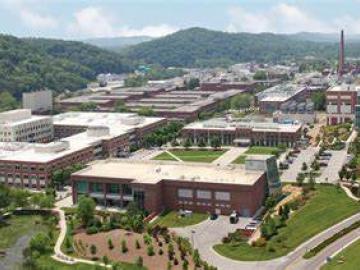Filter News
Area of Research
- Advanced Manufacturing (21)
- Biological Systems (1)
- Biology and Environment (109)
- Biology and Soft Matter (1)
- Building Technologies (1)
- Clean Energy (177)
- Climate and Environmental Systems (5)
- Computational Biology (2)
- Computational Engineering (2)
- Computer Science (1)
- Fusion and Fission (10)
- Fusion Energy (7)
- Isotopes (6)
- Materials (58)
- Materials for Computing (9)
- Mathematics (1)
- National Security (12)
- Neutron Science (27)
- Nuclear Science and Technology (17)
- Nuclear Systems Modeling, Simulation and Validation (1)
- Supercomputing (46)
- Transportation Systems (2)
News Type
News Topics
- (-) 3-D Printing/Advanced Manufacturing (106)
- (-) Advanced Reactors (29)
- (-) Biomedical (54)
- (-) Composites (23)
- (-) Environment (174)
- (-) Molten Salt (8)
- (-) Transportation (85)
- Artificial Intelligence (78)
- Big Data (42)
- Bioenergy (85)
- Biology (92)
- Biotechnology (19)
- Buildings (45)
- Chemical Sciences (52)
- Clean Water (27)
- Climate Change (84)
- Computer Science (171)
- Coronavirus (45)
- Critical Materials (22)
- Cybersecurity (34)
- Decarbonization (63)
- Education (3)
- Element Discovery (1)
- Emergency (1)
- Energy Storage (98)
- Exascale Computing (31)
- Fossil Energy (4)
- Frontier (34)
- Fusion (49)
- Grid (55)
- High-Performance Computing (74)
- Hydropower (11)
- Irradiation (2)
- Isotopes (44)
- ITER (7)
- Machine Learning (40)
- Materials (128)
- Materials Science (116)
- Mathematics (6)
- Mercury (12)
- Microelectronics (2)
- Microscopy (46)
- Nanotechnology (54)
- National Security (49)
- Net Zero (10)
- Neutron Science (119)
- Nuclear Energy (92)
- Partnerships (37)
- Physics (53)
- Polymers (27)
- Quantum Computing (28)
- Quantum Science (61)
- Renewable Energy (2)
- Security (22)
- Simulation (37)
- Software (1)
- Space Exploration (24)
- Statistics (2)
- Summit (55)
- Sustainable Energy (109)
- Transformational Challenge Reactor (7)
Media Contacts

Rishi Pillai and his research team from ORNL will receive a Best Paper award from the American Society of Mechanical Engineers International Gas Turbine Institute in June at the Turbo Expo 2024 in London.

ORNL’s Omer Onar and Mostak Mohammad will present on ORNL's wireless charging technology in DOE’s Office of Technology Transitions National Lab Discovery Series Tuesday, April 30.

ORNL’s Erin Webb is co-leading a new Circular Bioeconomy Systems Convergent Research Initiative focused on advancing production and use of renewable carbon from Tennessee to meet societal needs.

A first-ever dataset bridging molecular information about the poplar tree microbiome to ecosystem-level processes has been released by a team of DOE scientists led by ORNL. The project aims to inform research regarding how natural systems function, their vulnerability to a changing climate and ultimately how plants might be engineered for better performance as sources of bioenergy and natural carbon storage.

ORNL researchers are working to make EV charging more resilient by developing algorithms to deal with both internal and external triggers of charger failure. This will help charging stations remain available to traveling EV drivers, reducing range anxiety.

Scientists at ORNL have developed 3D-printed collimator techniques that can be used to custom design collimators that better filter out noise during different types of neutron scattering experiments

The Department of Energy’s Oak Ridge National Laboratory is providing national leadership in a new collaboration among five national laboratories to accelerate U.S. production of clean hydrogen fuel cells and electrolyzers.
ORNL scientists have determined how to avoid costly and potentially irreparable damage to large metallic parts fabricated through additive manufacturing, also known as 3D printing, that is caused by residual stress in the material.

SkyNano, an Innovation Crossroads alumnus, held a ribbon-cutting for their new facility. SkyNano exemplifies using DOE resources to build a successful clean energy company, making valuable carbon nanotubes from waste CO2.
The United States could triple its current bioeconomy by producing more than 1 billion tons per year of plant-based biomass for renewable fuels, while meeting projected demands for food, feed, fiber, conventional forest products and exports, according to the DOE’s latest Billion-Ton Report led by ORNL.




